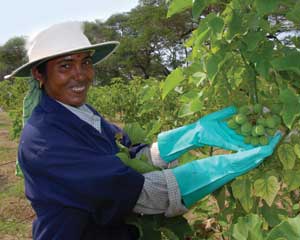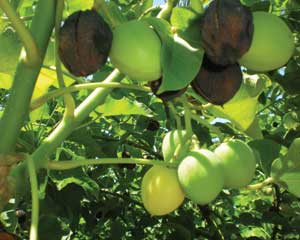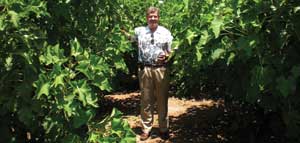The Truth Behind the Claims




October 14, 2008
BY Erin Krueger
Most commercially produced crops have an extensive history involving domestication, research and development. For example, mankind has been working to improve corn for more than 5,000 years. Jatropha has no such history. While the plant has been used in various parts of the world for medicinal applications, soap production, a source of lamp oil, and to construct living fences, its potential for large-scale oil production for biodiesel has only recently begun to be explored.
Jatropha research is underway in many locations around the globe, but no long-term comprehensive research has been completed on the cultivation of large monoculture plots. Furthermore, those involved in the plant's research and development have different opinions on what it will take to transform jatropha into an economically viable crop, and when the plant is expected to reach this benchmark.
Successful efforts to cultivate jatropha for use as a biodiesel feedstock are underway. However, most of this production is being done by individual farmers on a small scale. For example, European biofuels technology company D1 Oils is working with farmers in northeast India. It is estimated that nearly 60,000 hectares (148,263 acres) of jatropha have been planted in the region by nearly 60,000 different farmers each cultivating one or two hectares of the crop. The farming methods are labor intensive as they involve handpicking the crop, which may make it not viable for production in other areas of the world.
Although jatropha can grow in areas with marginal soil and little water, it does not produce significant oil yields under these conditions. To produce an abundant amount of oil, the plant must be cultivated in the proper location, watered and fertilized. In addition, the crop has no natural resistance to frost. Although specific U.S. climate zones within Hawaii, California and Florida may be able to support jatropha farming, it is expected that nearly all jatropha development will occur in areas closer to the equator. Countries in South and Central America, South Africa and select areas of Asia stand to benefit most from jatropha cultivation. A great deal of the land most suited to jatropha production is located within the borders of developing nations, so in those areas infrastructure issues, political stability, and economic environment may impact jatropha production.
Domesticating Jatropha
Although these social, political and economic issues are important, more research is needed to develop the crop before growers will be comfortable planting it on a commercial scale. Some of the first challenges that need to be addressed are increasing the volume and consistency of oil yields, and developing plants with more standard fruit maturation rates. The availability of mechanical harvesting techniques and the development of coproducts will also enhance the economic viability of the crop.
"Lack of domestication is a legitimate concern, and it can be addressed," says Russell Teall, president of Biodiesel Industries Inc. Teall's company has been heavily involved in jatropha research, including the completion of a five-year feasibility study in India at the request of the United States and Indian governments. Teall says having a good genetic base to work with is important. With current plant selections farmers will see a bell curve in productivity.
Michael Poteet, an agronomist at the Hawaii Agricultural Research Center, has been conducting jatropha field trials for two years. The first step in his research project was to accumulate jatropha seeds from around the world and evaluate them for suitability in Hawaii's climate and soil conditions. "With the materials we are working with right now, there is not a lot in the way of superior planting materials," Poteet says. "It is such a variable plant. You will get some individual trees that are extraordinarily productive-large fruit clusters, very aggressive fruit production-but, it's really hard to get that uniformity repeated over and over across multiple acres of trees."
Jatropha is a cross-pollinated plant, which means farmers can never be sure what they are getting genetically when planting from seeds. The most productive plants can be propagated using cuttings to create genetically identical plants. However, Poteet says jatropha that self-pollinates experiences high fruit abortion rates, where much of the fruit either drops from the tree or never reaches maturity. "You need some genetic diversity in place to get good yields," he says."
One of the biggest challenges facing Global Energy Trading Co., an organization developing jatropha farms in Peru and Columbia, is the maturation rate of jatropha fruit. The fruit grows in clusters, much like grapes. However, unlike grapes, the individual fruit within the clusters mature at different rates, making mechanized harvesting a challenge. James Fanning, the company's chief executive officer, says getting fruit within the clusters to ripen uniformly is the key to making jatropha a manageable crop in terms of labor.
Research is being completed to address these problems, but will take some time to develop. Graham Prince, communication director at D1 Oils, estimates his company will be able to develop a jatropha hybrid featuring consistent yields, height, flowering and fruiting within the next five to 10 years. "We are in the beginning of domestication of the crop," he says. "I think the process is actually becoming quite rapid."
While handpicking crops may make financial sense in some areas of the world, finding a way to mechanically harvest jatropha will be an important factor in developing the feedstock in industrialized nations. Poteet's organization has been exploring various ways to do this. Harvesters designed for coffee trees may work once the maturation rate of the fruit can be controlled. Another option Poteet is exploring involves harvesting all the biomass around the tree's parameter. This method would not only collect the fruit, but would induce more branching and flowering around the tree's exterior portions. Fruit could also be collected from the ground. Mike Reardon, owner of Farming Biodiesel Inc., a self-sufficient organic farm that grows jatropha near Desert Center, Calif., says he uses a modified nut shaker to drop ripe fruit to the ground. A vacuum system then collects the fallen fruit.
Developing Coproducts
Coproduct development is another important element in turning jatropha into a viable feedstock for biodiesel producers. The high-quality seedcake leftover after oil extraction could be fed to livestock. However, it has a low-protein value and must be detoxified before being fed to animals.
Roy Beckford, an agricultural and natural resources agent with Lee County Extension in Florida, has been working with local farmers to establish jatropha crops. He says the glycerin leftover from biodiesel production can potentially be marketed as a specialty product for use in pharmaceuticals because of its anti-inflammatory properties. Beckford says jatropha may also have some anticancerous properties that are currently being explored.
The Hawaii Agricultural Resource Center is researching jatropha's potential for latex production. "There is latex in the tree-in the biomass," Poteet says. "It can be recovered chemically, and it does appear to have some promise." Other coproducts being investigated include natural pesticides, fertilizers and fermentation of the seedcake to create methane gas.
The Future of Jatropha
Estimates of just how long it will take to develop these plant characteristics and coproducts vary. "We are learning much more about [jatropha's] characteristics," Prince says. "I think a lot of the initial over-enthusiasm is now passing, and we are getting a much more realistic picture of what is possible. I think that the realistic picture is still equally exciting."
According to Poteet, there isn't a lot of money supporting jatropha research right now. If that should change, he says, farmers could move into large-scale production within the next six to eight years with a support system in place to assist their efforts. "If there is a really slow trickle of support into the development of this, then I think you are looking at more than 10 years before we are really confident," Poteet says.
Beckford says if current trends continue, significant acreages of jatropha will be planted in Florida within the next five years. Some Florida farmers are already experimenting with small plots of the crop, and a handful are planning to develop plots of up to 100,000 acres in the near future.
It's important for people to do their homework before getting involved with jatropha, Teall says. "Jatropha is right in its infancy. It really hasn't been cultivated on a large scale." Although much more productive strains of jatropha will be available in the future, successful cultivation also requires finding the right location to grow the crop in terms of climate, economics and politics. "The law and regulations in a country really can make or break large-scale development," Teall says.
While jatropha holds a great deal of potential as a biodiesel feedstock, it is also important to acknowledge many hurdles must be overcome before the crop can become economically viable in most parts of the world. According to Teall, all feedstocks have their advantages and their disadvantages. Jatropha is no different.
Erin Voegele is a Biodiesel Magazine staff writer. Reach her at evoegele@bbiinternational.com or (701) 373-8090.
Jatropha research is underway in many locations around the globe, but no long-term comprehensive research has been completed on the cultivation of large monoculture plots. Furthermore, those involved in the plant's research and development have different opinions on what it will take to transform jatropha into an economically viable crop, and when the plant is expected to reach this benchmark.
Successful efforts to cultivate jatropha for use as a biodiesel feedstock are underway. However, most of this production is being done by individual farmers on a small scale. For example, European biofuels technology company D1 Oils is working with farmers in northeast India. It is estimated that nearly 60,000 hectares (148,263 acres) of jatropha have been planted in the region by nearly 60,000 different farmers each cultivating one or two hectares of the crop. The farming methods are labor intensive as they involve handpicking the crop, which may make it not viable for production in other areas of the world.
Although jatropha can grow in areas with marginal soil and little water, it does not produce significant oil yields under these conditions. To produce an abundant amount of oil, the plant must be cultivated in the proper location, watered and fertilized. In addition, the crop has no natural resistance to frost. Although specific U.S. climate zones within Hawaii, California and Florida may be able to support jatropha farming, it is expected that nearly all jatropha development will occur in areas closer to the equator. Countries in South and Central America, South Africa and select areas of Asia stand to benefit most from jatropha cultivation. A great deal of the land most suited to jatropha production is located within the borders of developing nations, so in those areas infrastructure issues, political stability, and economic environment may impact jatropha production.
Domesticating Jatropha
Although these social, political and economic issues are important, more research is needed to develop the crop before growers will be comfortable planting it on a commercial scale. Some of the first challenges that need to be addressed are increasing the volume and consistency of oil yields, and developing plants with more standard fruit maturation rates. The availability of mechanical harvesting techniques and the development of coproducts will also enhance the economic viability of the crop.
"Lack of domestication is a legitimate concern, and it can be addressed," says Russell Teall, president of Biodiesel Industries Inc. Teall's company has been heavily involved in jatropha research, including the completion of a five-year feasibility study in India at the request of the United States and Indian governments. Teall says having a good genetic base to work with is important. With current plant selections farmers will see a bell curve in productivity.
Michael Poteet, an agronomist at the Hawaii Agricultural Research Center, has been conducting jatropha field trials for two years. The first step in his research project was to accumulate jatropha seeds from around the world and evaluate them for suitability in Hawaii's climate and soil conditions. "With the materials we are working with right now, there is not a lot in the way of superior planting materials," Poteet says. "It is such a variable plant. You will get some individual trees that are extraordinarily productive-large fruit clusters, very aggressive fruit production-but, it's really hard to get that uniformity repeated over and over across multiple acres of trees."
Jatropha is a cross-pollinated plant, which means farmers can never be sure what they are getting genetically when planting from seeds. The most productive plants can be propagated using cuttings to create genetically identical plants. However, Poteet says jatropha that self-pollinates experiences high fruit abortion rates, where much of the fruit either drops from the tree or never reaches maturity. "You need some genetic diversity in place to get good yields," he says."
One of the biggest challenges facing Global Energy Trading Co., an organization developing jatropha farms in Peru and Columbia, is the maturation rate of jatropha fruit. The fruit grows in clusters, much like grapes. However, unlike grapes, the individual fruit within the clusters mature at different rates, making mechanized harvesting a challenge. James Fanning, the company's chief executive officer, says getting fruit within the clusters to ripen uniformly is the key to making jatropha a manageable crop in terms of labor.
Research is being completed to address these problems, but will take some time to develop. Graham Prince, communication director at D1 Oils, estimates his company will be able to develop a jatropha hybrid featuring consistent yields, height, flowering and fruiting within the next five to 10 years. "We are in the beginning of domestication of the crop," he says. "I think the process is actually becoming quite rapid."
While handpicking crops may make financial sense in some areas of the world, finding a way to mechanically harvest jatropha will be an important factor in developing the feedstock in industrialized nations. Poteet's organization has been exploring various ways to do this. Harvesters designed for coffee trees may work once the maturation rate of the fruit can be controlled. Another option Poteet is exploring involves harvesting all the biomass around the tree's parameter. This method would not only collect the fruit, but would induce more branching and flowering around the tree's exterior portions. Fruit could also be collected from the ground. Mike Reardon, owner of Farming Biodiesel Inc., a self-sufficient organic farm that grows jatropha near Desert Center, Calif., says he uses a modified nut shaker to drop ripe fruit to the ground. A vacuum system then collects the fallen fruit.
Developing Coproducts
Coproduct development is another important element in turning jatropha into a viable feedstock for biodiesel producers. The high-quality seedcake leftover after oil extraction could be fed to livestock. However, it has a low-protein value and must be detoxified before being fed to animals.
Roy Beckford, an agricultural and natural resources agent with Lee County Extension in Florida, has been working with local farmers to establish jatropha crops. He says the glycerin leftover from biodiesel production can potentially be marketed as a specialty product for use in pharmaceuticals because of its anti-inflammatory properties. Beckford says jatropha may also have some anticancerous properties that are currently being explored.
The Hawaii Agricultural Resource Center is researching jatropha's potential for latex production. "There is latex in the tree-in the biomass," Poteet says. "It can be recovered chemically, and it does appear to have some promise." Other coproducts being investigated include natural pesticides, fertilizers and fermentation of the seedcake to create methane gas.
The Future of Jatropha
Estimates of just how long it will take to develop these plant characteristics and coproducts vary. "We are learning much more about [jatropha's] characteristics," Prince says. "I think a lot of the initial over-enthusiasm is now passing, and we are getting a much more realistic picture of what is possible. I think that the realistic picture is still equally exciting."
According to Poteet, there isn't a lot of money supporting jatropha research right now. If that should change, he says, farmers could move into large-scale production within the next six to eight years with a support system in place to assist their efforts. "If there is a really slow trickle of support into the development of this, then I think you are looking at more than 10 years before we are really confident," Poteet says.
Beckford says if current trends continue, significant acreages of jatropha will be planted in Florida within the next five years. Some Florida farmers are already experimenting with small plots of the crop, and a handful are planning to develop plots of up to 100,000 acres in the near future.
It's important for people to do their homework before getting involved with jatropha, Teall says. "Jatropha is right in its infancy. It really hasn't been cultivated on a large scale." Although much more productive strains of jatropha will be available in the future, successful cultivation also requires finding the right location to grow the crop in terms of climate, economics and politics. "The law and regulations in a country really can make or break large-scale development," Teall says.
While jatropha holds a great deal of potential as a biodiesel feedstock, it is also important to acknowledge many hurdles must be overcome before the crop can become economically viable in most parts of the world. According to Teall, all feedstocks have their advantages and their disadvantages. Jatropha is no different.
Erin Voegele is a Biodiesel Magazine staff writer. Reach her at evoegele@bbiinternational.com or (701) 373-8090.
Advertisement
Advertisement
Upcoming Events





